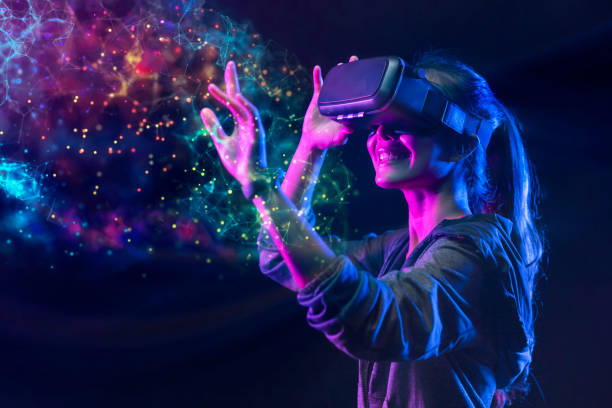The rapid evolution of technology has continuously transformed how humans interact with the digital and physical worlds. Among the most revolutionary developments in recent years are Augmented Reality (AR) and Virtual Reality (VR)—two technologies that are redefining perception, experience, and engagement. While AR overlays digital information onto the real world, VR immerses users completely in a computer-generated environment. Together, they are part of a broader technological trend known as Extended Reality (XR), encompassing the entire spectrum between the physical and digital realms. The future of AR and VR holds enormous potential, with implications for entertainment, education, healthcare, business, design, and even human communication itself. As hardware, software, and connectivity advance, these technologies are moving beyond novelty and into the fabric of everyday life.
Understanding Augmented Reality and Virtual Reality
To appreciate their future, it is essential to understand what AR and VR fundamentally are. Virtual Reality replaces the real-world environment with a fully simulated digital space. Through specialized headsets, gloves, and sometimes even haptic suits, users can explore and interact with computer-generated worlds. It creates a sense of presence—a psychological state in which users feel physically immersed in the digital environment. Whether traversing alien landscapes, exploring historical reconstructions, or simulating industrial processes, VR allows experiences that are otherwise impossible in the physical world.
Augmented Reality, on the other hand, enhances the physical world by adding layers of digital information. Through smartphones, tablets, smart glasses, or heads-up displays, AR integrates visual, auditory, and sometimes tactile feedback with the user’s real environment. This blending of digital and physical realities enables users to see holographic data overlaid on their surroundings, such as navigation cues on streets, product details in retail stores, or maintenance instructions on industrial machinery.
Both technologies rely on advanced hardware and software, including sensors, cameras, motion tracking, and spatial computing. AR and VR are not isolated innovations but interconnected components of a growing digital ecosystem that includes artificial intelligence (AI), 5G connectivity, cloud computing, and the Internet of Things (IoT). Their convergence with these technologies is setting the stage for an entirely new dimension of human experience.
The Evolution of AR and VR Technologies
The journey of AR and VR began decades ago, long before their current popularity. The earliest experiments in virtual reality can be traced back to the 1960s, when computer scientist Ivan Sutherland created the “Sword of Damocles,” a primitive head-mounted display that projected simple wireframe graphics. Although bulky and limited, it introduced the core concept of immersive visualization. During the following decades, research in simulation, 3D graphics, and motion tracking advanced steadily, particularly within military and academic contexts.
In the 1990s, early commercial VR systems emerged, but their high cost, poor image quality, and limited computing power prevented widespread adoption. Similarly, the concept of augmented reality began to take shape in the late 1990s and early 2000s, initially through experimental applications in industrial design and military aviation. However, the consumer revolution in AR and VR truly began in the 2010s, with the convergence of mobile computing, high-resolution displays, and motion sensors. The launch of devices such as the Oculus Rift, HTC Vive, and PlayStation VR brought immersive experiences to gamers and developers alike. Meanwhile, AR applications like Pokémon GO and Snapchat filters demonstrated how augmented overlays could captivate global audiences.
Today, AR and VR technologies are evolving at an exponential pace. Lightweight headsets, spatial mapping, eye tracking, and real-time 3D rendering are becoming standard features. The development of mixed reality devices—such as Microsoft HoloLens, Apple Vision Pro, and Meta Quest—marks a new phase where the boundaries between augmented and virtual realities blur. These systems allow users to seamlessly switch between fully immersive and partially augmented environments, depending on context and need.
The Role of Hardware in the Future of AR and VR
The hardware that powers AR and VR experiences has undergone dramatic improvements, yet further innovation is needed to make these technologies truly ubiquitous. Current headsets are lighter, more ergonomic, and more affordable than their predecessors, but challenges remain regarding comfort, battery life, and resolution. The next generation of AR and VR hardware is expected to focus on achieving near-photorealistic visuals, natural interactivity, and seamless integration with the user’s environment.
Advances in display technology will play a crucial role. Future headsets will likely use microLED or OLED displays capable of delivering ultra-high pixel density and dynamic range. Eye-tracking technology will enable foveated rendering, which optimizes graphics processing by rendering only the area where the user’s gaze is focused in full detail. This approach not only enhances realism but also reduces computational load and energy consumption.
Moreover, improvements in sensors and motion tracking will enhance spatial awareness and reduce latency. Haptic feedback systems, such as gloves or suits that simulate touch and texture, will make virtual interactions feel increasingly real. Brain-computer interfaces (BCIs) are another emerging frontier that could allow direct neural input and output, potentially revolutionizing how users control and perceive virtual environments.
In the case of AR, wearable devices must balance functionality with aesthetics and comfort. Smart glasses that look and feel like ordinary eyewear are essential for mass adoption. Achieving this requires breakthroughs in miniaturization, energy efficiency, and optical engineering. Companies such as Apple, Meta, and Google are investing heavily in creating AR glasses capable of projecting high-fidelity digital content onto real-world surfaces without bulky hardware. When such devices become mainstream, AR will seamlessly integrate into daily life, just as smartphones did in the 2000s.
The Power of Software and Content Ecosystems
Hardware provides the interface, but software defines the experience. The future of AR and VR depends on robust software ecosystems that support diverse applications. Game engines such as Unreal Engine and Unity have already become foundational platforms for developing immersive content. Their ability to render lifelike 3D environments and simulate realistic physics enables creators to design experiences that rival real life.
Beyond entertainment, enterprise software is transforming industries through AR and VR solutions. In architecture and construction, professionals use virtual walkthroughs to visualize projects before they are built. In manufacturing, AR interfaces guide workers through complex assembly processes, reducing errors and improving efficiency. In retail, virtual showrooms allow customers to interact with products before making purchasing decisions. As cloud computing and AI integration advance, these applications will become more intelligent and responsive, adapting to user behavior and environmental context in real time.
A critical component of this evolution will be the development of open standards and interoperability. The creation of shared virtual spaces—sometimes referred to as the metaverse—requires that AR and VR systems from different manufacturers can communicate and exchange data seamlessly. Initiatives like OpenXR are working toward this goal by providing cross-platform compatibility, enabling developers to build once and deploy everywhere.
The Role of Artificial Intelligence in AR and VR
Artificial intelligence is becoming an indispensable partner in the evolution of AR and VR. AI enhances realism, interactivity, and personalization by allowing systems to interpret and respond to the user’s environment and actions intelligently. In AR, computer vision algorithms powered by AI allow devices to recognize objects, map surroundings, and anchor digital elements to real-world surfaces. This capability enables applications such as AR navigation, object identification, and contextual information overlays.
In VR, AI-driven avatars and virtual characters can simulate realistic human behavior and emotions, creating immersive social and training experiences. Machine learning algorithms can also predict user intentions, making interactions more intuitive. For example, AI can anticipate a user’s next move in a game, adjust environmental conditions in real time, or personalize virtual environments to suit individual preferences.
AI’s role in content generation is another transformative factor. Procedural generation techniques allow for the creation of vast and dynamic virtual worlds with minimal human input. Generative AI models can design environments, characters, and narratives that evolve in response to user interactions, leading to experiences that are unique for every individual. As AI continues to integrate with AR and VR systems, the line between programmed experiences and emergent realities will become increasingly blurred.
The Impact of 5G and Cloud Computing
Connectivity is the backbone of immersive technology. The rollout of 5G networks and the growth of cloud computing are critical enablers for the future of AR and VR. High-bandwidth, low-latency communication allows data to be processed and streamed in real time, removing the need for bulky on-device computation. This shift will lead to lighter, more affordable devices that rely on powerful cloud servers to render complex environments.
For AR, this means that digital overlays can be updated and synchronized instantly across multiple users and locations. Imagine a team of engineers wearing AR glasses collaboratively working on a machine, each seeing the same digital instructions in real time. In VR, cloud rendering enables massive multiplayer experiences and persistent virtual worlds that evolve continuously, accessible from any device connected to the network.
Edge computing—processing data closer to the source rather than in distant data centers—will further enhance performance by reducing latency. This architecture will be crucial for applications that demand instantaneous response, such as AR navigation, industrial control, or remote surgery. As 5G and edge networks expand globally, the infrastructure for truly ubiquitous AR and VR will solidify.
The Convergence of AR, VR, and the Metaverse
The term “metaverse” has gained immense attention as a vision of interconnected virtual spaces where users can work, play, socialize, and create. Although still in its early stages, the metaverse represents the convergence of AR, VR, AI, and blockchain technologies into a unified digital continuum. In this ecosystem, virtual and augmented realities coexist, allowing seamless transitions between immersive digital worlds and enhanced physical experiences.
In the metaverse, users may own digital assets represented by non-fungible tokens (NFTs), participate in virtual economies, and interact with realistic avatars powered by AI. Education, commerce, and entertainment will merge into interactive environments that transcend geographic and physical limitations. For example, students could attend virtual classrooms that simulate historical events, while professionals could collaborate in 3D workspaces that feel as real as meeting in person.
However, realizing this vision requires addressing significant technical, social, and ethical challenges. Standardization, data privacy, security, and governance will play crucial roles in ensuring that the metaverse develops as an open, inclusive, and safe digital environment rather than a fragmented or monopolized space.
The Role of AR and VR in Education and Training
One of the most transformative applications of AR and VR lies in education and training. Traditional learning methods often struggle to engage students or provide hands-on experience. AR and VR can overcome these barriers by offering immersive and interactive environments where learners can explore complex concepts through direct experience. In VR, students can visit ancient civilizations, dissect virtual organisms, or conduct dangerous experiments safely. In AR, they can visualize molecular structures, view annotations over physical objects, or receive guided instructions in real time.
In professional training, these technologies are already proving invaluable. Medical students practice surgical procedures in virtual operating rooms, allowing for repetition without risk. Pilots, firefighters, and military personnel use VR simulations to prepare for high-stress scenarios. Industrial workers use AR interfaces that display maintenance instructions overlaid on machinery, improving accuracy and reducing downtime. The future of education will increasingly rely on these technologies to create personalized, adaptive learning experiences that combine theoretical knowledge with practical skill development.
AR and VR in Healthcare
Healthcare is another domain where AR and VR are driving remarkable innovation. Surgeons can use AR to visualize internal anatomy during operations, enhancing precision and reducing complications. VR therapy is being used to treat mental health conditions such as phobias, PTSD, and anxiety through controlled exposure in safe virtual environments. Rehabilitation programs employ VR to gamify physical therapy, motivating patients to recover more effectively.
AR can also assist in diagnostics, allowing doctors to visualize data such as MRI scans superimposed on patients’ bodies. Medical education benefits enormously from both AR and VR, as students can practice procedures repeatedly in virtual settings without risk to real patients. In the future, advances in haptic feedback and real-time imaging may allow remote surgeries, where expert surgeons operate from across the world using VR-assisted robotic systems.
The Transformation of Entertainment and Media
The entertainment industry has been one of the earliest and most enthusiastic adopters of AR and VR. Gaming, in particular, has driven much of the technology’s development, but its applications extend far beyond play. VR offers filmmakers, artists, and musicians new ways to tell stories, enabling audiences to step inside the narrative rather than merely observe it. Immersive concerts, interactive films, and virtual art galleries are expanding the definition of creative expression.
AR, too, is transforming media consumption. Sports broadcasts can overlay real-time statistics on the field, museums can bring exhibits to life with interactive displays, and theme parks can create hybrid experiences that merge the physical and digital. As the hardware becomes more widespread, the distinction between digital entertainment and reality will continue to dissolve, ushering in an era of participatory storytelling where audiences are part of the experience itself.
The Future Workplace and Remote Collaboration
The future of work is being reshaped by AR and VR technologies. As remote collaboration becomes the norm, virtual offices and meeting spaces offer new ways for teams to connect. Instead of staring at flat video conference grids, employees can meet as avatars in shared 3D environments, review designs together, or brainstorm ideas using virtual tools. AR can overlay digital data on physical workspaces, helping employees visualize analytics or project updates in real time.
Enterprises are also adopting these technologies for training, design, and customer engagement. Engineers can prototype and test products virtually before manufacturing, reducing costs and development time. Real estate agents can offer virtual tours, and customer service representatives can provide guided assistance through AR interfaces. As spatial computing becomes more advanced, the distinction between digital and physical workspaces will fade, creating truly hybrid working environments.
Ethical, Privacy, and Social Considerations
As AR and VR become more pervasive, ethical and social challenges will intensify. Privacy is a major concern, as these technologies rely on collecting vast amounts of data about users and their environments. Eye tracking, motion sensors, and spatial mapping generate detailed personal information that could be misused if not properly protected. Safeguarding user data and ensuring transparency in how it is used will be critical for maintaining public trust.
Another concern is the potential for addiction, isolation, or disconnection from reality. The immersive nature of VR can lead some individuals to prefer virtual experiences over real interactions. Society must address how to balance the benefits of these technologies with their psychological impacts. Additionally, accessibility must remain a priority. Ensuring that AR and VR are inclusive and affordable will prevent the emergence of a digital divide where only certain groups benefit from technological advancements.
Ethical questions also arise in the context of virtual ownership and identity. As users invest time, creativity, and resources in digital spaces, issues of property rights, authorship, and accountability must be addressed. Governance frameworks will need to evolve to handle disputes, protect intellectual property, and define acceptable behavior in virtual environments.
The Road Ahead: Challenges and Opportunities
The future of AR and VR will be shaped by how society addresses these challenges and capitalizes on emerging opportunities. Technological progress alone will not determine success—social acceptance, regulatory frameworks, and ethical considerations will be equally important. Interdisciplinary collaboration between engineers, designers, policymakers, and ethicists will be essential to guide development responsibly.
Opportunities are immense. As hardware becomes more affordable, software more sophisticated, and networks faster, AR and VR will become integral to daily life. They will change how people learn, communicate, heal, and entertain themselves. They will create new industries and transform existing ones. The evolution of AR and VR represents not just a technological revolution but a cultural one—reshaping how humans perceive reality itself.
Conclusion
The future of Augmented Reality and Virtual Reality is not a distant vision but an unfolding reality. These technologies are transitioning from experimental novelties to indispensable tools that redefine human experience. They promise to merge the digital and physical worlds into a seamless continuum, enabling new forms of creativity, collaboration, and understanding.
As AR and VR continue to advance, their influence will extend across every domain of life—from education and healthcare to art, industry, and communication. The boundaries between what is real and what is virtual will continue to blur, giving rise to new ways of thinking and being. The challenge for humanity is to harness this power responsibly, ensuring that the future of AR and VR enhances rather than diminishes human connection, creativity, and well-being. The coming decades will not merely see the evolution of technology but the redefinition of what it means to experience reality itself.






